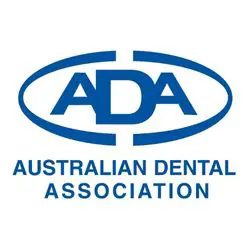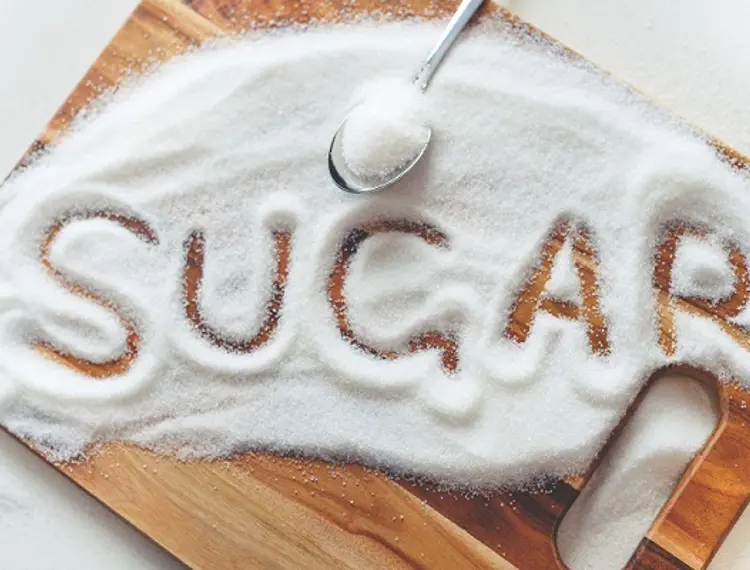
Key messages
- Sugar is one of the biggest factors that can lead to the development of tooth decay.
- Adults are recommended to have 6 teaspoons or less of sugar per day to decrease their risk of tooth decay.
- One teaspoon of sugar equals 4 grams of sugar.
Sugar is one of the biggest factors that can lead to the development of tooth decay. The World Health Organization (WHO) recommends adults have six or less teaspoons of free sugar. This equals 24 grams of sugar. This amount decreases your risk of tooth decay and unhealthy weight gain.
Free sugar, added sugar and natural sugar are all commonly used to describe sugar.
- adding sugar to your coffee
- sprinkling sugar over your breakfast cereal
- sugar added to a cake recipe.
Can natural sugar and added sugar affect my teeth the same?
Yes.
However, foods such as fruit and milk are made up of small amounts of natural sugars as well as fibre, vitamins, and minerals which are good for the body. Milk also includes calcium, which can help to protect your teeth and bones.
Processed foods that include large amounts of added sugar often have no or limited nutritional value.
Understanding the Nutrition Information Panel and sugar
Understanding how to find sugar on the labels of foods and drinks and how much is present can help you to protect your teeth.
Sugar comes in many forms.
Sugars can be called over 50 different names. This can make it tricky to find them on food and drink labels. These are known as hidden sugars. Get to know the different types of sugar to help you find them when looking at food and drink labels.
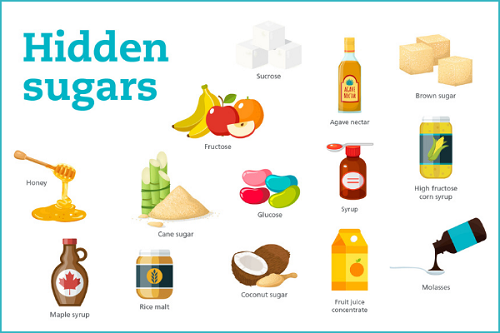
If you see any of the below names listed as an ingredient, this is adding sugar to your food or drink.
- Sucrose
- Maltose
- Lactose
- Fructose
- Brown rice syrup
- Glycose syrup
- Palm sugar
- Agave nectar
- Golden syrup
- Honey
- Molasses
- Corn syrup
- Cane sugar
- Brown rice syrup
- Maltodextrin
- Raw sugar
On average, one can of soft drink contains 10 teaspoons of sugar. This is 1.5 times the daily sugar intake recommended by the WHO.
Only 6 or less teaspoons (24 grams) of free sugar are recommended daily. This amount is equal to 5% of the average persons daily total energy intake (kJ). Kilojoules are the measurement of energy from foods and drinks. Your body uses this energy to function. Some countries call these calories. For reference, 8360kJ = 2000Kcal.
The average adult needs about 8,700 kJ a day to keep a healthy weight.
Calculating sugar consumption based on 5% of 8,700 kJ* (daily total energy).
5% of 8700kJ
0.05 x 8700kJ = 435kJ
435kJ = 6.3 teaspoons of sugar per day
68kJ (approximate kilojoules in
1 teaspoon of sugar)
*This is based on an average. If you are looking for more information about what is right for you and your health, talk to your doctor or an Accredited Practicing Dietician.
The Nutrition Information Panel (NIP) is included on foods and drinks to tell you the ingredients and nutrients in the product. You can use the NIP to compare products to make healthy choices.
How to read the sugar values
Use the 100 grams column to help you to decide between products. This lets you compare 'apples with apples.' The serving size is set by the manufacturer so it can be different between products. This makes comparing products difficult. If you use the sugar per serve column, you may be comparing 'apples with oranges' instead.
When looking at the 100g column, choosing products with:
- 5 grams or less of sugar is BEST
- between 5g and 10g of sugar is OKAY
- over 15g of sugar - TRY TO FIND A HEALTHIER ALTERNATIVE.
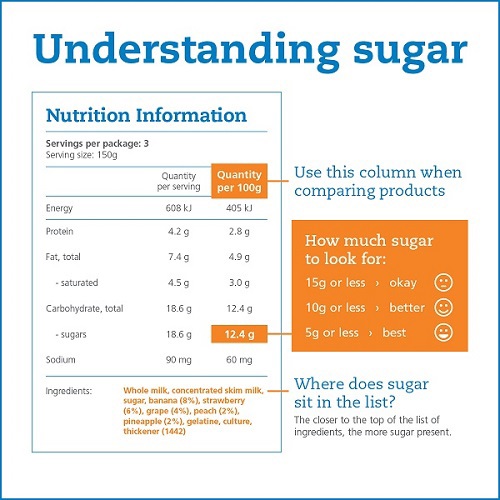
Many products will not clearly say the amount of added sugar in the food or drink. You may need to read the list of ingredients to find the added sugars. The closer an ingredient is to the top of the list, the more of it that is present.
Sugar can go by over 50 different names so this can make it tricky to find all the sources of sugar.
You will often hear sugar measured as a number of teaspoons. This way of measuring sugar makes it easier to see the amount of sugar you are having.
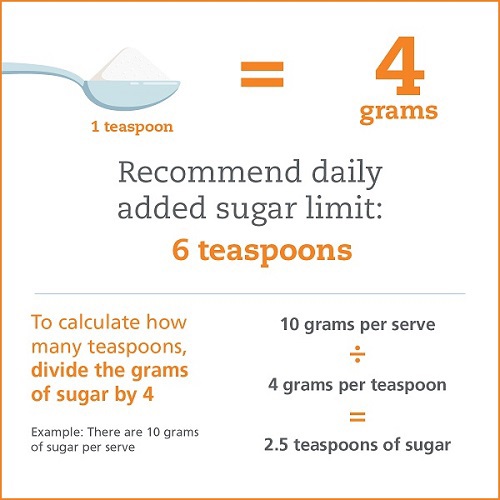
How do I find a healthy option?
Health Star Ratings are a quick and easy way to help you choose healthier packaged foods and drinks.
The Health Star Rating System is a food labelling system used in Australia and New Zealand. It started in 2014. Manufacturers of packaged foods and drinks may choose to put a star rating on the label of their product. The star ratings range from ½ to 5 stars. The rating is made using a calculator that looks at nutrients and ingredients in the food or drink. The higher the stars, the healthier the food or drink is compared similar products. The lower the star rating, the less healthy the food or drink is.
Check out this guide for using the Health Star Rating.
